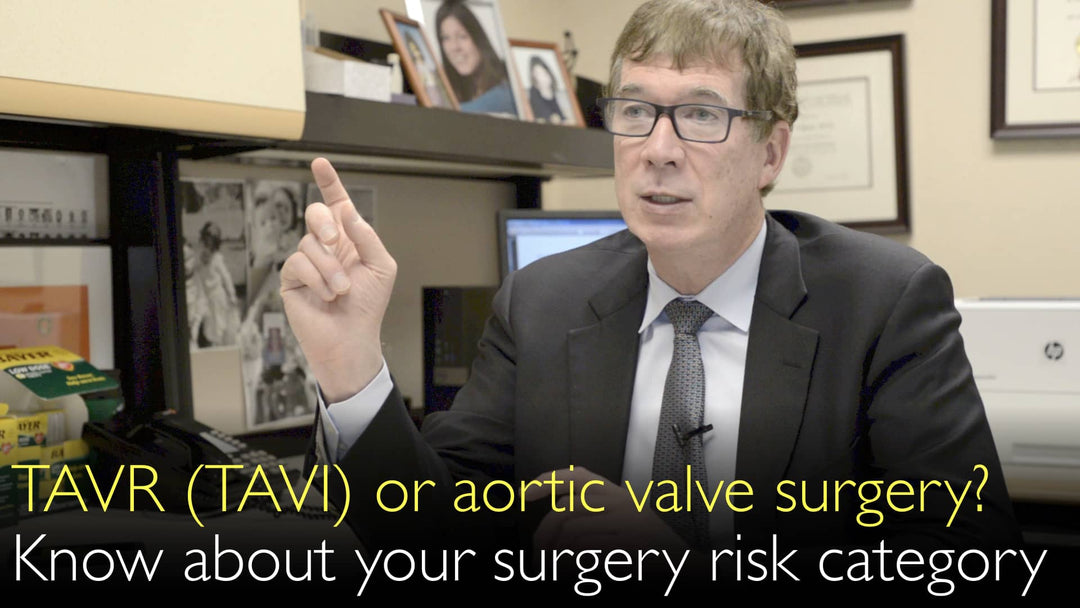Leading expert in interventional cardiology, Dr. Jeffrey Popma, MD, explains how to choose between TAVR and open heart surgery for aortic valve replacement. He details the multidisciplinary team approach to surgical risk assessment. Dr. Popma outlines key factors like the STS risk score, frailty, and comorbidities. He also discusses the latest FDA approvals for TAVR valves in intermediate-risk patients. The interview covers the importance of aortic valve anatomy in preventing prosthesis-patient mismatch.
TAVR vs. Open Heart Surgery: A Guide to Aortic Valve Replacement Choices
Jump To Section
- Multidisciplinary Risk Assessment
- Surgical Risk Categories
- TAVR Valve Approvals
- Key Risk Assessment Factors
- Aortic Valve Anatomy Importance
- Future TAVR Frontiers
- Full Transcript
Multidisciplinary Risk Assessment
Dr. Jeffrey Popma, MD, emphasizes that assessing surgical risk for aortic valve replacement begins with a multidisciplinary team. This team includes heart surgeons, interventional cardiologists, non-invasive cardiologists, and nurse practitioners. This collaborative approach ensures a comprehensive evaluation of each patient's unique situation. The goal is to determine the safest and most effective treatment path for severe aortic stenosis.
Surgical Risk Categories
Dr. Jeffrey Popma, MD, classifies patients based on their predicted surgical risk. A key benchmark is a 30-day mortality rate exceeding 3%, which defines elevated surgical risk. Patients are then categorized as high-risk or extreme-risk for traditional open heart surgery. Dr. Jeffrey Popma, MD, notes that for some patients, the risk may be so prohibitive that no intervention is the recommended course. This risk stratification is fundamental to guiding the choice between TAVR and surgery.
TAVR Valve Approvals
The interview with Dr. Anton Titov, MD, highlights the expansion of TAVR to more patients. Dr. Jeffrey Popma, MD, confirms FDA approval for two major TAVR systems in intermediate-risk patients. These are the Evolut TAVR valve from Medtronic and the Sapien 3 TAVR valve from Edwards Lifesciences. Dr. Popma observes that as TAVR becomes suitable for more patients, the lines between risk categories can become somewhat arbitrary. This makes the initial multidisciplinary assessment even more critical.
Key Risk Assessment Factors
Dr. Jeffrey Popma, MD, details the specific factors his team evaluates. The STS predictive risk mortality score is a primary benchmark for estimating surgical risk. Beyond this number, clinicians assess patient frailty and disability levels. They determine if a patient can care for themselves at home. Co-morbidities like severe lung disease or liver disease are also major considerations in the final treatment recommendation.
Aortic Valve Anatomy Importance
The anatomy of the aortic valve itself is a crucial factor in procedure selection. Dr. Jeffrey Popma, MD, explains that patients with a very small aortic annulus, specifically under 20 millimeters, may be better candidates for TAVR. A transcatheter valve can often avoid a complication known as prosthesis-patient mismatch. This occurs when the implanted prosthetic valve is too small for the patient's body size, limiting blood flow. Advanced heart imaging is essential for making these precise anatomical assessments.
Future TAVR Frontiers
Dr. Jeffrey Popma, MD, discusses the remaining frontiers for transcatheter aortic valve replacement. The next major area of study is proving TAVR's superiority in lower-risk patient populations. Another important frontier involves treating patients with complex congenital aortic valve abnormalities. A common example is bicuspid aortic valve disease, which presents unique anatomical challenges for both surgical and transcatheter approaches. Dr. Anton Titov, MD, facilitates this forward-looking discussion on the evolution of aortic stenosis treatment.
Full Transcript
Dr. Anton Titov, MD: Choosing TAVR or TAVI or open heart surgery to replace an aortic valve can be difficult. A leading cardiologist explains how to make procedure choices in aortic stenosis treatment. How do you assess surgical risks for patients who are thinking about transcatheter aortic valve replacement?
Dr. Jeffrey Popma, MD: Yes. The assessment of surgical risk really starts with a multidisciplinary team. It includes heart surgeons, interventional cardiologists, non-invasive cardiologists, and nurse practitioners.
In patients with aortic stenosis who are elderly, the fundamental goal right now is to say this: "Are they at elevated risk for surgery?" This technically means a 30-day mortality rate over 3%. Then we arbitrarily classify patients into high-risk and extreme risk.
Dr. Anton Titov, MD: Some patients shouldn't get anything at all.
Dr. Jeffrey Popma, MD: So now there has been approval for two aortic valves for transcatheter replacement. It is the Evolut TAVR aortic valve with the Medtronic CoreValve system. There is also the Sapien 3 TAVR valve with the Edwards system in intermediate-risk patients.
Some of those differentiations in patients become a little bit arbitrary, because all the patients would be suitable for TAVR or TAVI.
Dr. Anton Titov, MD: But the parameters that we look at is a standardized risk. It is so-called the STS predictive risk mortality.
Dr. Jeffrey Popma, MD: That's a benchmark. It tells us what the surgical risk of the patient would be. Then we look at a variety of different parameters related to the patient's frailty and to their disability.
Dr. Anton Titov, MD: Can patients care for themselves at home? What are the patient’s co-morbidities? Do they have bad lung disease or bad liver disease?
Dr. Jeffrey Popma, MD: Finally, we have a more contemporary method to start looking at the aortic valve anatomy. Patients that have a very small aortic annulus under 20 millimeters.
Dr. Anton Titov, MD: For them, maybe a transcatheter aortic valve would be more favorable than a surgical valve.
Dr. Jeffrey Popma, MD: This helps to avoid a syndrome called "prosthesis-patient mismatch". We use a lot of heart imaging methods.
We perform surgical evaluation, cardiologist's evaluation, and general cardiologist's imaging evaluation. We come up with what the patient's risk of aortic valve replacement procedure is.
Now the only frontier that we really have left to prove for TAVR superiority are the lower-risk patients. We have to identify the best aortic valve replacement procedure in patients with congenital abnormalities.
Dr. Anton Titov, MD: For example, bicuspid aortic valve disease.







